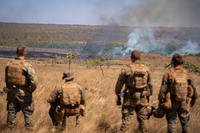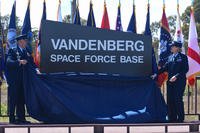SOUTHWEST ASIA -- Airmen supporting U.S. Central Command's Deployment and Distribution Operation Center, a strategically located air, land and sea logistics hub, are playing a critical role in the U.S. departure from Afghanistan.
The 405th Air Expeditionary Group Airmen have completed more than 2,900 missions and moved more than 23,000 pieces of cargo to and from the area of responsibility -- primarily supporting Afghanistan operations -- from an undisclosed location in Southwest Asia.
Well-known for their 2010 role in receiving and rushing heavy Mine-Resistant Ambush Protected vehicles and other equipment into Afghanistan in record time, the Airmen have reversed processes to speed Afghanistan retrograde efforts.
"This multi-modal mission was designed by U.S. Transportation Command and CENTCOM to get the needed equipment to the fight more efficiently," said Col. Keith Thibodeaux, 405th Air Expeditionary Group commander.
"The air method was very costly but we were able to move everything very fast. As the requirement continued to grow we needed a cheaper way to do this," said Thibodeaux. "That's where the multi-modal concept came into play."
Today, Airmen fly C-17s loaded with equipment out of Afghanistan to the 405th AEG airfield. Equipment is downloaded from the aircraft and then trucked two hours to the port and loaded onto ships. Aerial transport, the most expensive shipping option, is reduced from 18 hours to three, according to Thibodeaux.
By flying the equipment to the 405th AEG from theater and then shipping by sea, the military saves time and money. In 2010, TRANSCOM estimated it saved more than $450 million in airfreight costs.
We have increased the cargo flow through this multi-modal hub since this last summer, said Thibodeaux. "We were moving about 150 pieces a month and now we are moving about 400 a month. So, while we continue to move more and more cargo, we are doing it cost-efficiently and are saving tax payer dollars."
Every day and around the clock, as equipment arrives, aerial porters rapidly prepare it for transport. At the same time, fuels specialists refuel transport aircraft to speed their departure. A support team including fire fighters, security forces, vehicle maintainers and many more contribute to the mission.
"It's a very unique group of people. It's a total force effort," Thibodeaux said. "There are about 800 people here and you will never know if they are active duty, Guard or Reserve. There are also six different chains of command on this base that are supporting three four-star generals and two combatant commanders; however everyone works together to get the mission done successfully."


























